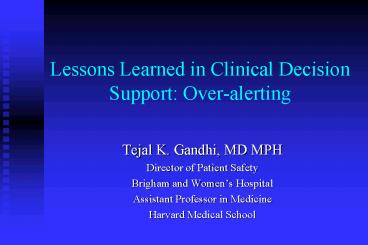Lessons Learned in Clinical Decision Support: Overalerting - PowerPoint PPT Presentation
1 / 25
Title:
Lessons Learned in Clinical Decision Support: Overalerting
Description:
Overall alert acceptance higher at tiered site (29% vs 10%, p .001) ... Streamlined knowledge bases and tiered alerting have higher acceptance rates ... – PowerPoint PPT presentation
Number of Views:58
Avg rating:3.0/5.0
Title: Lessons Learned in Clinical Decision Support: Overalerting
1
Lessons Learned in Clinical Decision Support
Over-alerting
- Tejal K. Gandhi, MD MPH
- Director of Patient Safety
- Brigham and Womens Hospital
- Assistant Professor in Medicine
- Harvard Medical School
2
Overriding of Alerts
- Studies have shown that MDs override clinical
decision support alerts a large percent of the
time - 88 of inpatient DDI alerts overridden (Payne et
al. Proc AMIA 2002) - 83 of inpatient drug-allergy alerts (Abookire et
al. Proc AMIA 2000) - 89 of outpatient high severity DDI alerts and
91 of outpatient drug-allergy alerts (Weingart
et al. Arch Intern Med 2003)
3
Are Overrides Appropriate?
- 7,761 drug-allergy alerts in BWH inpatients,
Aug-Oct 2002 - Alerts were overridden 80 of the time
- In chart review of 300 overrides, all were
clinically justified - Evidence that we are over-alerting
- Only 6 of alerts were triggered by an exact
match between drug ordered and drug in allergy
list (lots of potential noise)
Hsieh et al. JAMIA 2004
4
Alerts Triggered by Exact Drug-Allergy Matches
are Rare
- Ordered drug
- Hydromorphone (DILAUDID) (N18)
- Drug in allergy list
- Codeine (39)
- Oxycodone (22)
- Meperidine (22)
- Morphine (17)
- Hydromorphone (0)
5
Alerts Triggered by Exact Drug-Allergy Matches
are Rare
- Ordered drug
- Furosemide (LASIX) (N18)
- Hydrochlorothiazide (N4)
- Drug in allergy list
- Sulfa (95)
- Furosemide (5)
- Sulfa (100)
- Hydrochlorothiazide (0)
6
Allergy Alerting Recommendations
- Need better specificity of alerts to avoid false
positives - E.g. requiring exact matches for certain classes
- Good news FDB recently removed lasix/HCTZ
sulfa interaction
7
Overall Alerting Issues
- Need more studies to maximize effectiveness of
alerts/ minimize over-alerting - Issue of how best to display the messages
- Need to learn from other industries (industrial
engineering)
8
Drug-Pregnancy Level 1
9
(No Transcript)
10
Potential Strategies to Improve Alerting
- Creation of streamlined knowledge bases
- Only essential content
- Balance between sensitivity and specificity
- Tiering of alerts is also a possibility
- Hard stop
- Interruptive
- Non-interruptive
- Minimizing interruptions
11
Impact of Reduced Alerting on Override Rates
- Study in the ambulatory setting
- Decision support included
- Duplicate drug
- Drug-disease
- Drug-drug
- Drug-lab
- Drug-pregnancy
Shah et al. JAMIA 2006
12
Knowledge base streamlining
- Expert panel
- Physicians, pharmacists, informaticians
- Reviewed sources
- Vendor knowledge-bases, pre-existing locally
created KBs, literature - Removed certain alerts and tiered the rest
13
Alert tiers
- Level 1 Potentially life-threatening
- E.g., erythromycin - diltiazem -gt V-fib
- Hard stop couldnt proceed
- Level 2 Potential for serious injury
- Rizatriptan - linezolid -gt serotonin syndrome
- Interruptive, required a reason
- Level 3 Use w/ caution
- Warfarin levofloxacin -gt increased PT
- Noninterruptive
14
(No Transcript)
15
16
Actions w/ level 2 alerts
- Cancel
- Do not proceed with order
- Modify, examples include
- Alter the problem list
- Discontinue the pre-existing drug
- Hold the other medication
- Accept defined as cancel or modify
- Override defined as not accept
17
Results
- Final knowledge base
- 2 level 1 63 level 2, 35 level 3
- 18,115 alerts
- 12,933 non-interruptive (71)
- 5,182 interruptive (29)
- Of 5,182 interruptive alerts
- 3475 (67) accepted
18
Interruptive alerts
19
Summary of Reduced Alerting Study
- Can reduce alert burden by streamlining and
tiering the knowledge base - Concept of a non-interruptive alert may be
helpful - Still need more research on what is optimal level
of alerting - Are we missing things is always the worry
20
Non-interruptive alerts
21
(No Transcript)
22
Impact of Non-Interruptive Alerts
- Drilled down into the drug-lab alerts
- No difference in lab ordering between control and
intervention groups - Is it a user interface issue or are
non-interruptive alerts just not effective? - Cost- benefit issue
- Minimize interruptions so higher risk alerts are
accepted more often yet little benefit seen with
non-interruptive alerts
23
Impact of Tiering on Inpatient DDI Alerts
- Two academic medical centers
- Same knowledge base
- Site A used 3 tiers
- Site B had all of the alerts as interruptive
(Level 2) - Overall alert acceptance higher at tiered site
(29 vs 10, plt.001)
Paterno, et al. Unpublished data.
24
Tiered Inpatient DDI Acceptance Rates
- Level 1 Acceptance rates
- 100 (hard stop) vs 34 (not a hard stop)
- Level 2 Acceptance rates
- 29 vs 11
- Likely higher at tiered site since less alert
fatigue because fewer interruptive alerts
25
Conclusions
- Streamlined knowledge bases and tiered alerting
have higher acceptance rates - Especially for very high risk alerts
- Non-interruptive alerts may have little value
- What is our ideal acceptance rate??
Sensitivity/specificity? Best way to display? - More work needs to be done to maximize the
clinical benefits - Sharing of streamlined knowledge should be
widespread - No need to reinvent the wheel































